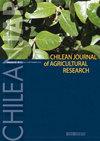小麦试验区秸秆和粮食产量及株高的最佳取样量
IF 1.7
4区 农林科学
Q2 Agricultural and Biological Sciences
引用次数: 0
摘要
选择具有代表性的采样区域进行准确可靠的小麦产量评估,对于优化秸秆在土壤中的保留及其作为生物燃料原料的去除具有重要意义。2020年在华北地区4块麦田进行了田间试验。4个样地小麦秸秆和籽粒产量分别为359.2 ~ 682.8和338.5 ~ 640.4 g m -2,株高为51.3 ~ 59.7 cm。秸秆、籽粒产量和株高估计值的相对偏差(RD)或标准误差(SE)随随机抽样平方数(1平方约为1 m²)和随机抽样株数(RSP)的增加而减小。在秸秆和谷物产量估算中,3-10和1-10 m2的相对相对过低值分别需要满足2 / 3地块的相对相对过低值小于5%。这表明可以推荐10平方米作为每个地块的最小RSS数。然而,在秸秆和谷物产量估算的RD区间(0 ~ 5%),从10 m2的RSS数来看,RD的发生率分别为63.75%和60.00%,表明田间试验中rs的产量容易发生较大变化。因此,强烈建议设计尽可能大的地块,并采全地块进行产量估算。小麦田间试验的阈值RSP数在14 ~ 18之间,以满足RD小于1.5%的要求;推荐最小RSP数为每小区20株(包括主蘖和分蘖)。本文章由计算机程序翻译,如有差异,请以英文原文为准。
Optimum sampling size for straw and grain yields and plant height in experimental plots of wheat
Selection of a representative sampling area for accurate and reliable yield evaluation of wheat ( Triticum aestivum L.) is important for optimizing straw retention in soils and its removal as biofuel feedstock. A field experiment was conducted at four wheat fields in the North China in 2020. Wheat straw and grain yields varied from 359.2-682.8 and 338.5-640.4 g m -2 , respectively, and plant height varied from 51.3-59.7 cm across all plots in the four sites. Variation in either relative deviation (RD) or standard error (SE) of straw and grain yield and plant height estimates decreased with the increase in random sampling square (RSS) (one square = approximately 1 m²) and random sampling plant (RSP) numbers, respectively. Minimum RSS numbers of 3-10 and 1-10 m 2 were needed to satisfy RD less than 5% in two-third of the plots for straw and grain yield estimates, respectively. This suggests that 10 m 2 could be recommended as the minimum RSS number per plot. However, the incidence frequency of RD was 63.75% and 60.00% within the RD interval of 0%-5% for straw and grain yield estimates, respectively, from the RSS number of 10 m 2 , indicating that yields from RSSs in field trials are prone to large variations. Therefore, it is strongly recommended to design a large plot as possible and to harvest the whole plot for estimating yields. The threshold RSP number ranged from 14-18 to satisfy RD less than 1.5% and a minimum RSP of 20 plants (including mains and tillers) per plot could be recommended for wheat field experiments.
求助全文
通过发布文献求助,成功后即可免费获取论文全文。
去求助
来源期刊
CiteScore
3.00
自引率
11.80%
发文量
60
审稿时长
6 months
期刊介绍:
ChileanJAR publishes original Research Articles, Scientific Notes and Reviews of agriculture, multidisciplinary and agronomy: plant production, plant protection, genetic resources and biotechnology, water management, soil sciences, environment, agricultural economics, and animal production (focused in ruminant feeding). The editorial process is a double-blind peer reviewing, Editorial Office checks format, composition, and completeness, which is a requirement to continue the editorial process. Editorial Committee and Reviewers evaluate relevance and scientific merit of manuscript.

 求助内容:
求助内容: 应助结果提醒方式:
应助结果提醒方式:


